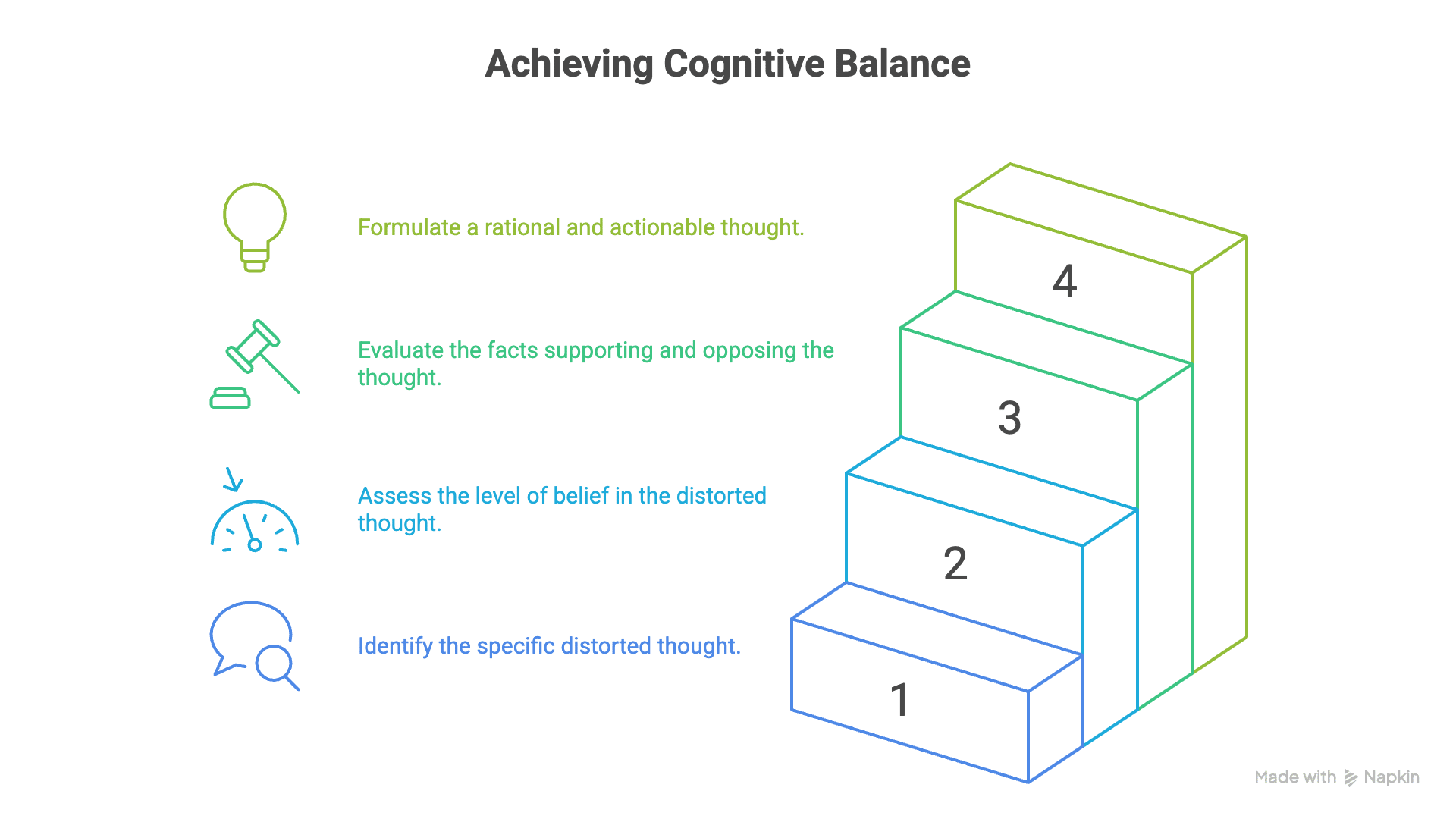Name It to Tame It: 7 Common Thought Distortions (and Fixes)
Your brain is a fast prediction machine. It uses shortcuts to keep you safe. Helpful in danger; rough on everyday life. Those shortcuts can twist how you see yourself, other people, and the future. Psychologists call these cognitive distortions—habits of thought that lean negative and feel true in the moment.
The good news: distortions are common and trainable. The cognitive model of psychopathology explains how biased thoughts drive difficult emotions and behavior, and how these cognitive distortions influence behaviors by shaping the way we react and act in various situations. Modern CBT treats those patterns directly.
Research also shows that anxiety disorders often come with elevated distortions, which is one reason anxiety can snowball. See this investigation of cognitive distortions in panic disorder, generalized anxiety, and social anxiety for a clear picture of how they show up. These distorted thought patterns can significantly impact people’s lives, affecting their well-being and daily functioning.
How to Use This Guide
- Read the quick definition.
- Spot where it shows up in your day.
- Try the one‑minute reframe. Keep it simple and testable.
What Are Cognitive Distortions?
Cognitive distortions are biased thinking patterns that jump to extremes, ignore context, or treat feelings like facts. Your brain loves speed: it completes patterns, predicts danger, and fills gaps. That’s efficient—and sometimes wrong. A distorted thought can lead to an exaggerated emotional response, influencing how you feel about a situation.
A quick DC example: a friend hasn’t texted back. Your mind leaps to, “They’re done with me.” That snap judgment might reflect anxiety, not reality. These patterns also get louder online, where brief posts and missing context invite assumptions. People who report more depression also tend to express more distorted thinking on social media—these are examples of distorted thoughts that can amplify negative emotions, a reminder to pause before believing every hot thought.
The 7 Distortions
1) All‑or‑Nothing Thinking (Black‑and‑White)
Spot it: If it isn’t perfect, you see it as a total failure. All-or-nothing thinking is an extreme form of cognitive distortion, characterized by rigid, black-and-white judgments. You grade the day as 0 or 100 and ignore everything in between.
Try this reframe: Ask, “What’s the middle here?” Draw a 0–100 ladder. Place today at a fair number (maybe 62/100). Name one action that would move it +5 points. Partial wins count.
Example: “I stumbled once in the presentation, so it was a disaster.” Reframe: “I hit 80% of my points. Next time I’ll keep a one‑line prompt per slide.”
2) Catastrophizing (Worst‑Case Thinking)
Spot it: One setback → total disaster. Your mind screens only the scenes where everything falls apart. Catastrophizing often involves assuming that negative outcomes will occur in all future events, not just the current situation.
Try this reframe: Write three lines: Worst / Best / Most Likely. Plan for the most likely case plus one small safeguard for the worst. You’re not denying risk; you’re right‑sizing it.
Example: “If I speak up, I’ll get fired.” Reframe: “Most likely: my idea gets heard or parked. I’ll run it by a colleague first.”
3) Mind Reading
Spot it: “I know what they think”—without evidence. You infer motives from silence, facial expressions, or a single message.
Try this reframe: Convert your claim into a question you can test. Ask directly, clarify, or wait for more data. Draft a neutral text or email before you decide what their silence “means.”
Why it spikes online: Short posts lack context, and algorithms reward heat. In that setting, assumptions multiply. Research finds that people with more depression‑related symptoms express more distorted thinking on social media—use that as a cue to slow down and check your read.
4) Fortune Telling
Spot it: You predict failure before you start. The future is a foregone conclusion, and it’s bad. For example, you might think, “I just know I’ll mess up this presentation,” or “There’s no way I’ll get the job.” These are examples of fortune telling, where you assume a negative outcome without evidence.
Try this reframe: Run the 3‑trial rule. Try the thing three times. Measure what actually happens. Then adjust. Let data—not fear—drive the next step.
Context: Distortions often run hot when anxiety is high, which can make the future feel fixed. See this study on cognitive distortions across common anxiety disorders for how that pattern shows up clinically.
5) Mental Filter / Discounting the Positive
Spot it: One negative detail blocks out a day of positives. Compliments bounce off; criticism sticks. People often overlook positive aspects of their day or themselves, focusing only on negatives.
Try this reframe: Make two columns: Kept out vs Let in. Add at least three “let in” facts before you rate the day. To counteract the filter, list positive events and positive experiences from the day. If that feels fake, quote the actual words you heard.
Example: “They mentioned one typo, so the report was terrible.” Reframe: “They called it clear and useful, then noted one fix. I’ll correct it and keep the template.” People may also dismiss positive similar situations, not just the current one, as part of this distortion.
Mental Filter / Discounting the Positive is also known as disqualifying the positive, where individuals dismiss or reject positive experiences or achievements.
6) Overgeneralization & Labeling
Spot it: A single event becomes a global judgment—about you or them. Words like “always,” “never,” or global labels (e.g., “I’m incompetent,” “They’re impossible”). Mislabeling refers to assigning a negative label to yourself or others based on a single event, which is an extreme form of overgeneralization.
Try this reframe: Get specific: behavior + time + place. Swap labels for verbs. “I missed a deadline on Tuesday because the scope changed late. Next time I’ll ask for a checkpoint.”
7) Personalization & Blame
Spot it: You take total blame—or give all the blame—when outcomes have many causes. This often pairs with an illusion of control (“If I’d tried harder, nothing bad would’ve happened”).
Try this reframe: Draw a quick pie chart of causes. Assign rough percentages. Then act on the slice you actually control.
The 4‑Step Reset (A One‑Minute Drill)
- 1. Name it (what distortion is active? (identify the distorted thought)).
- 2. Rate certainty (0–100%).
- 3. Run the evidence test (facts for/against; what would you tell a friend?).
- 4. Write the balanced thought (one sentence you could act on today).
This is a bite‑size version of cognitive restructuring within cognitive‑behavioral therapy—challenging distorted beliefs and replacing them with more accurate, workable thoughts.
You can use this reset process to address the most common cognitive distortions described above.
When Self‑Help Isn’t Enough
- Signs you’re stuck: nonstop loops, panic spikes, or problems at work, school, or home that don’t budge (for example, a negative performance review can trigger cognitive distortions).
- What therapy adds: guided practice, accountability, and deeper work on the patterns under your negative thinking. Evidence‑based approaches like CBT have decades of development behind them; see this 40‑year retrospective on cognitive therapy for context and progress.
Therapy Group of DC: How We Can Help
Inclusive, research‑informed care in Dupont Circle. In‑person and telehealth.
Ready to get unstuck? Start therapy with Therapy Group of DC.
Closing note: Brains bend the story; you can bend it back. With practice—and sometimes a therapist—you can think more clearly and feel steadier.
Frequently Asked Questions About Cognitive Distortions
What are thought distortions and how do they affect mental health?
Thought distortions, also known as cognitive distortions, are irrational thoughts and biased thinking patterns that often lead to negative emotions and psychological damage. Cognitive distortions can be shaped by past experiences, which influence how we interpret situations.
They can worsen mental health conditions like anxiety and depression by reinforcing negative thought patterns and distorted thinking. Negative thought patterns can contribute to decreased motivation and low self-esteem. Sometimes, people mistake their own opinions for facts, which can further distort their perception of reality.
How can I recognize automatic negative thoughts in myself?
Becoming aware of automatic negative thoughts involves recognizing habitual thinking errors such as black and white thinking, mental filtering, and emotional reasoning. Cognitive distortions often operate automatically and are difficult to recognize without awareness. Paying attention to when you focus only on negative aspects or jump to conclusions can help you identify these distorted thoughts. Focusing on negative things, rather than seeing the whole picture, is a common sign of cognitive distortion.
What is the role of emotional reasoning in distorted thinking?
Emotional reasoning is when unpleasant feelings are mistaken for facts, causing you to believe your emotions reflect reality. Emotional reasoning is the belief that feelings are facts, which can distort reality. This can also cause you to feel guilty, especially when you believe you are responsible for negative outcomes based solely on your feelings. This can lead to distorted thinking patterns that ignore actual evidence and contribute to negative emotions and poor emotional wellbeing.
How does cognitive restructuring help in overcoming cognitive distortions?
Cognitive restructuring is a therapeutic technique that involves challenging distorted thoughts by examining clear evidence and reframing cognitive distortions into more balanced and positive ways of thinking. Mindfulness and cognitive behavioral therapy (CBT) are effective tools in managing cognitive distortions. This process supports improved self-esteem and emotional wellbeing.
When should I seek help from a mental health professional?
If cognitive distortions lead to persistent negative emotions, interfere with daily functioning, or cause psychological damage, consulting a mental health professional can provide guidance. Cognitive distortions can create tension in relationships and feelings of isolation. Professionals can assist with identifying thinking errors, assigning blame appropriately, and developing positive ways to cope. Control fallacies often arise from two beliefs: that you have no control and are a victim, or that you have complete control over everything, both of which can be addressed in therapy.


